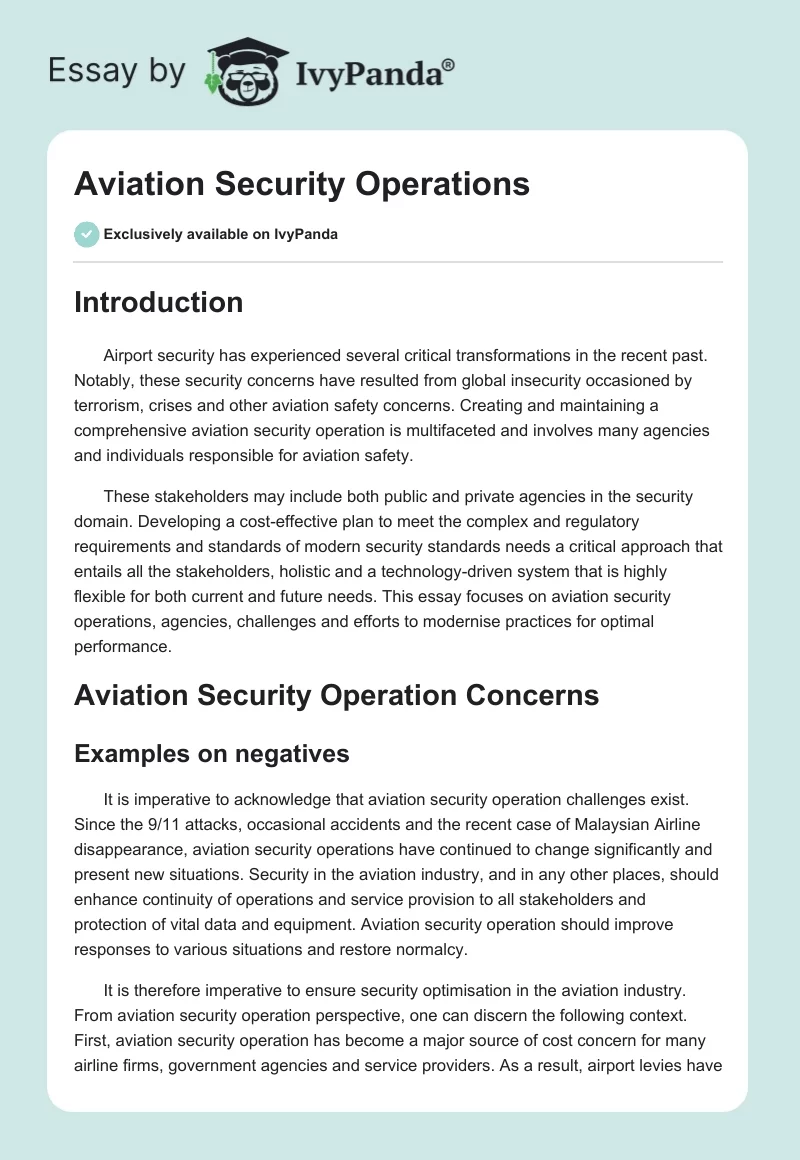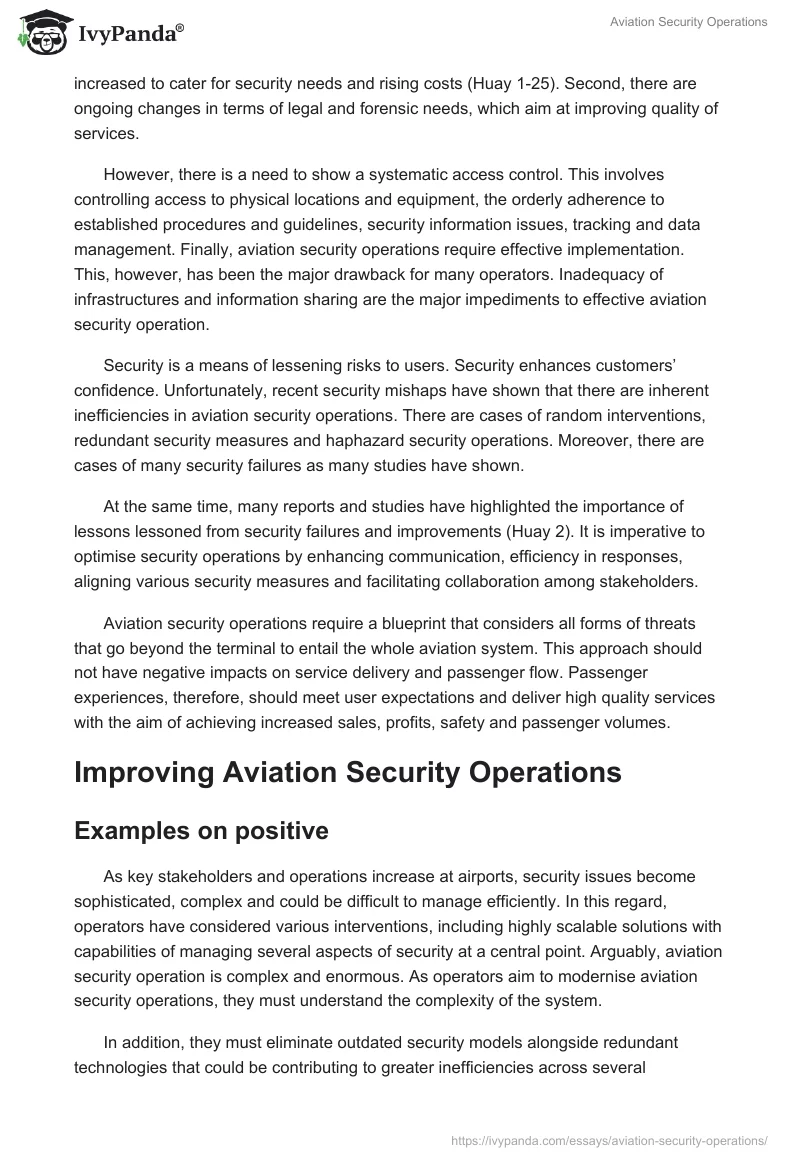Introduction
Airport security has experienced several critical transformations in the recent past. Notably, these security concerns have resulted from global insecurity occasioned by terrorism, crises and other aviation safety concerns. Creating and maintaining a comprehensive aviation security operation is multifaceted and involves many agencies and individuals responsible for aviation safety.
These stakeholders may include both public and private agencies in the security domain. Developing a cost-effective plan to meet the complex and regulatory requirements and standards of modern security standards needs a critical approach that entails all the stakeholders, holistic and a technology-driven system that is highly flexible for both current and future needs. This essay focuses on aviation security operations, agencies, challenges and efforts to modernise practices for optimal performance.
Aviation Security Operation Concerns
Examples on negatives
It is imperative to acknowledge that aviation security operation challenges exist. Since the 9/11 attacks, occasional accidents and the recent case of Malaysian Airline disappearance, aviation security operations have continued to change significantly and present new situations. Security in the aviation industry, and in any other places, should enhance continuity of operations and service provision to all stakeholders and protection of vital data and equipment. Aviation security operation should improve responses to various situations and restore normalcy.
It is therefore imperative to ensure security optimisation in the aviation industry. From aviation security operation perspective, one can discern the following context. First, aviation security operation has become a major source of cost concern for many airline firms, government agencies and service providers. As a result, airport levies have increased to cater for security needs and rising costs (Huay 1-25). Second, there are ongoing changes in terms of legal and forensic needs, which aim at improving quality of services.
However, there is a need to show a systematic access control. This involves controlling access to physical locations and equipment, the orderly adherence to established procedures and guidelines, security information issues, tracking and data management. Finally, aviation security operations require effective implementation. This, however, has been the major drawback for many operators. Inadequacy of infrastructures and information sharing are the major impediments to effective aviation security operation.
Security is a means of lessening risks to users. Security enhances customers’ confidence. Unfortunately, recent security mishaps have shown that there are inherent inefficiencies in aviation security operations. There are cases of random interventions, redundant security measures and haphazard security operations. Moreover, there are cases of many security failures as many studies have shown.
At the same time, many reports and studies have highlighted the importance of lessons lessoned from security failures and improvements (Huay 2). It is imperative to optimise security operations by enhancing communication, efficiency in responses, aligning various security measures and facilitating collaboration among stakeholders.
Aviation security operations require a blueprint that considers all forms of threats that go beyond the terminal to entail the whole aviation system. This approach should not have negative impacts on service delivery and passenger flow. Passenger experiences, therefore, should meet user expectations and deliver high quality services with the aim of achieving increased sales, profits, safety and passenger volumes.
Improving Aviation Security Operations
Examples on positive
As key stakeholders and operations increase at airports, security issues become sophisticated, complex and could be difficult to manage efficiently. In this regard, operators have considered various interventions, including highly scalable solutions with capabilities of managing several aspects of security at a central point. Arguably, aviation security operation is complex and enormous. As operators aim to modernise aviation security operations, they must understand the complexity of the system.
In addition, they must eliminate outdated security models alongside redundant technologies that could be contributing to greater inefficiencies across several international airports. Such cases have led to delays, congestion and decline in revenues and passenger volumes. While several systems, such as physical barriers, luggage screening, surveillance cameras, access control and intrusion detection among others are installed to enhance aviation security operations, technologies could effective in improving aviation security operations (Martonosi 153).
Video surveillance has become a critical element in aviation security operations. Therefore, incorporating video analytics skills to enhance efficiency can prove effective. For instance, video analytics can facilitate certain security breaches by identifying abnormal behaviour patterns, abandoned luggage and passenger movement among others. Such attempts aim to improve security situations in the aviation industry. In addition, they also have a greater potential of reducing costs of operations. Centralised security monitoring systems provide opportunities to leverage available facilities and control one or many airports.
While aviation security organisations and other experts have adopted many systems and sub-systems to monitor security situations, there is a growing concern that many surveillance systems and the generated data could overwhelm operators. Thus, information overload could lead to security breaches. Consequently, it is imperative to harness and manage all data generated effectively by planning and controlling data interpretation into useful information.
Data, therefore, should provide actionable insights that security operators could rely and act upon for improved safety and security optimisation. Once security analysts gain useful insights from the data gathered, they can initiate intelligent and effective responses immediately to counteract the perceived security threat. When security officers have the right information at the right moment in their control systems, they can evaluate the risk and offer effective solution when required. This is a proactive approach to aviation security operations.
Additionally, such data can control and guide security operators as they implement well-developed interventions through a central system. Data gathered from the system also support effective and fast decision-making. Consequently, a central system can eliminate redundancy and human errors associated with complex situations and emergency cases.
Apart from international organisations in the aviation industry, all countries also have their security agencies, private service providers and other operators. In addition, airports consist of several users, systems and multiple stakeholders. The complexity may create challenges. However, effective sharing of information among all stakeholders could facilitate decision-making and improve security in the aviation industry. Shared resources may offer several advantages to security monitors at the airport.
Such resources offer clearly defined approaches. For instance, several stakeholders could rely on a single system to fulfil various security needs without compromising vital security operations. In cases of any major concerns, control of shared resources may be transferred to a control unit for protection purposes. Sharing of resources at the aviation industry can reduce cost substantially.
International Air Transport Association (IATA) and other organisations have recognised the need for highly trained managers involved in air security operations, operational managers, cargo services personnel and effective response to security situations. As a result, they have emphasised the relevance of training and development among individuals who monitor aviation security operations at all levels.
Knowledge and skills in core aviation security operations have become vital for individuals who make decisions and ensure effective security operations. Therefore, it is important for managers and their juniors to understand security operational areas, procedures, processes and audit. They should be able to identify, analyse and thwart threats. Still, such individuals must ensure compliance with the aviation security guidelines. New knowledge and emerging technologies will ensure that operators can minimise operational exposure and reduce risks through effective risk management strategies.
Some of the airports, particularly in developing nations do not have adequate capacities to optimise aviation security operations at their levels. They are also need to comply with the new and changing aviation security international standards. This has proved to be a difficult task for many security agencies and private operators. Outsourcing of aviation security operations to professional firms could be effective and efficient approach of optimising aviation security operations. Many security experts and firms observe regulatory requirements and conform to the industry best practices, standards and developing trends.
Operators may only decide to outsource such services if they lack internal capacities to handle them. Aviation security operators may outsource all or specific options to third parties. These may include recruitment and training of security personnel, technology implementation, security improvement and security project management among others. Outsourcing could provide improved services, save costs and ensure that aviation security requirements meet international standards and best practices.
International Civil Aviation Organisation (ICAO) has noted that there are human factors alongside technology in aviation security operations (International Civil Aviation Organization 56). In this respect, many security officers face a difficult task with regard to accurate interpretation of X-Ray images (McLay, Jacobson and Kobza 1). As new technologies continue to evolve for evaluating various security threats, many agencies fail to equip their officers with the necessary skills and knowledge.
Consequently, effective implementation and usages of such technologies have suffered drawbacks. Generally, effectiveness of new technologies shall depend greatly on the expertise of security officers and operators. In this regard, there is a need for enhanced training to improve efficiency. At the same time, system developers must design security platforms for ease of use. Thus, human factors can find it simple to minimise errors. This approach, however, requires careful consideration of the aviation industry operational conditions and specific organisational culture.
Conclusion
It is imperative to note that aviation security operations require considerable amounts of resources and investments in personnel and equipment. Swafford observed that IT has become a critical component of aviation security operations (Swafford 1). Consequently, he noted that there was a need to strengthen security of physical infrastructure, staff must uphold their professional codes of ethics and IT systems must enhance efficiency.
Various stakeholders, including government agencies and private service providers must ensure that key security resources are available. Consequently, security officers should perform their roles effectively and ensure attention to details. Clearly, there are massive technical efforts to improve aviation security operations globally. However, global airports are still vulnerable to various security threats, including terrorism and cyber attacks. It is therefore necessary to identify potential sources of risks and develop mitigation strategies.
Finding relevant clues to aviation security threats must focus on various activities, including passenger flows and questionable abnormal behaviours (Stewart 1). In this regard, all industry stakeholders should be vigilant, collaborate, share information and resources to identify certain elements that could pose serious risks to airport and passenger security. Additionally, new models or solutions are required to tackle sophisticated risks (Barnett 909).
Works Cited
Barnett, Arnold. “CAPPS II: The Foundation of Aviation Security?” Risk Analysis 24.4 (2004): 909–916. Print.
Huay, Tan Siew. Airport Security. 2007.
International civil aviation organization. Doc 9808 AN/765 “Human factors in civil aviation security operations. Montreal, Canada: ICAO, 2002. Print.
Martonosi, Susan Elizabeth. An Operations Research approach to aviation security. Massachusetts: Massachusetts Institute of Technology, 2005. Print.
McLay, Laura A., Sheldon H. Jacobson and John E. Kobza. Making Skies Safer: Applying operations research to aviation passenger prescreening systems. 2005.
Stewart, Scott. Convergence: The Challenge of Aviation Security. 16 Sept. 2009.
Swafford, Steven M. International Airport Cyber Security Challenges. 2011.


